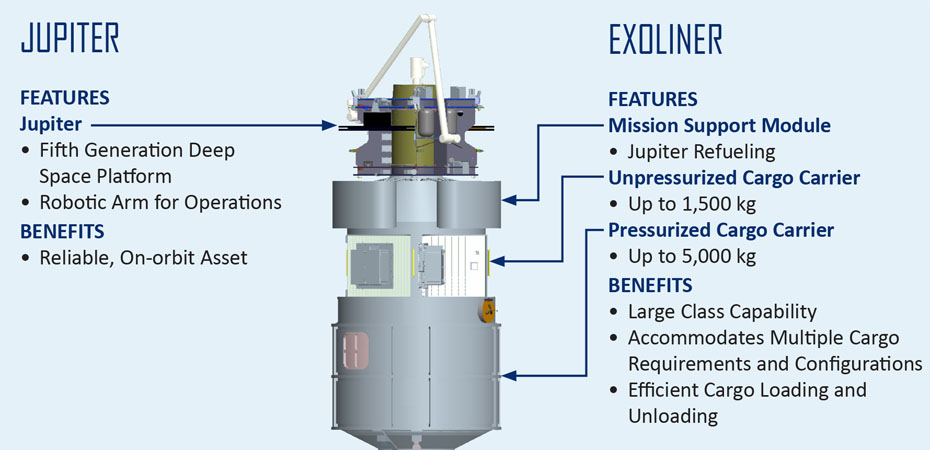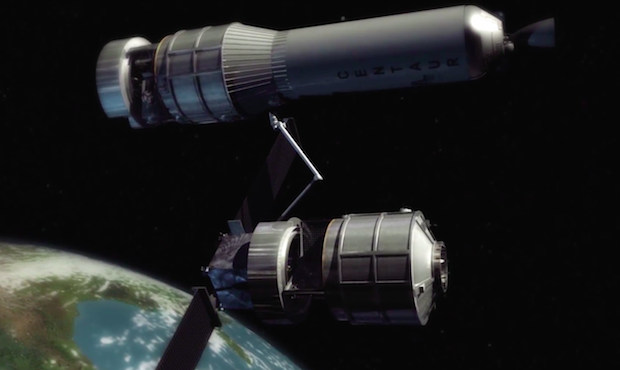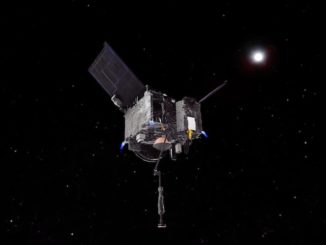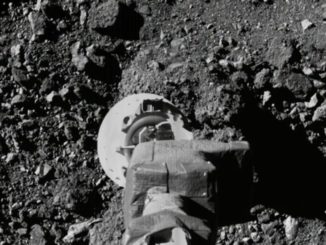
Lockheed Martin has proposed a semi-reusable resupply platform to send up cargo to the International Space Station beginning in 2018, adding another competitor to a crowded list of companies bidding to win multibillion-dollar contracts from NASA.
The robotic logistics carrier would loft heftier cargo than any other vehicle currently servicing the space station and use a long-lived satellite to pick up supply containers launched into orbit, then fly the equipment to the crew aboard the 250-mile-high research laboratory.
Officials pitched the idea Thursday in a presentation at Union Station in Washington, D.C., promoting the resupply platform as an affordable way to transport cargo and as a concept that could assist NASA’s plans to send astronauts on voyages into deep space in the 2020s.
Made of two segments, the logistics spacecraft can deliver and dispose up to 6,500 kilograms — 14,330 pounds — of supplies on each mission, including internal cargo and equipment to operate outside the International Space Station.
“It basically consists of a module in the back that’s based on an interplanetary spacecraft — our fifth-generation interplanetary spacecraft — not unlike a train,” said Jim Crocker, vice president of international business at Lockheed Martin Space Systems. “Basically, this module is like a locomotove. The module in the front, which is much like a flat car and a rail car, is what carries the cargo. Then, not unlike a train coupling, we have a robotic arm that allows us to connect and disconnect the pieces of this system together.”
The Jupiter satellite — based on the same platform Lockheed Martin built for NASA’s MAVEN Mars orbiter — and Exoliner cargo carrier would launch from Cape Canaveral aboard a United Launch Alliance Atlas 5 rocket, then rendezvous with the space station, where the lab’s 58-foot robotic arm will grapple the spacecraft and attach it to the complex.
Like the station’s existing servicing vehicles, astronauts would unpack the gear and install trash and unnecessary items for disposal as the spacecraft burns up in the atmosphere.
Then the spacecraft would depart the space station.

“Here’s where things get different,” Crocker said. “At this point, we can remain on orbit for months while we’re waiting for the next cargo resupply mission, and at that time we can launch CubeSats and small satellites, we can carry out Earth observation and do many other tasks away from station.
“On the subsequent launch, we only launch the shipping container,” Crocker said. “We don’t have expensive computers. We don’t have sensors and navigation systems which are thrown away and burned up, or in the case of some systems, returned to the ground to be refurbished and then have to be relaunched and carry all that mass.”
Another Exoliner cargo module would launch on an Atlas 5 rocket when the space station needs fresh supplies. The launcher’s Centaur upper stage would put the container in orbit, and the Jupiter spacecraft would approach the rocket, deploy its own mini-robotic arm, and swap out the older garbage-packed Exoliner compartment with the module launched with new cargo.
The Centaur stage would guide the space station’s trash for destruction over the ocean, and the Jupiter satellite will return to the outpost for a fresh delivery.
“If you had a garbage truck pick up your garbage at your house, and then went to the landfill and the whole thing drove off into the landfill, it would not be a very economical solution,” Crocker said. “Here, what we do is basically reuse the truck to bring the cargo back and forth up to the International Space Station.”
Officials said the Lockheed Martin-built Jupiter spacecraft contains the most expensive components of the cargo system, including navigation aids and a robot arm manufactured by MDA Corp. in Canada, the supplier of robotics for the space station and the space shuttle.
The Exoliner cargo module would come from Thales Alenia Space, which built several space station modules and pressurized cargo carriers for Europe’s Automated Transfer Vehicle and the Orbital ATK Cygnus supply ship.
Officials identified the reuse of the Jupiter spacecraft is a key feature of the Lockheed Martin concept, which is going up against proposals from other aerospace titans in hopes of winning a NASA contract in June.
NASA is expected to select at least two companies for second-round Commercial Resupply Services, or CRS-2, contracts to deliver and dispose hardware from 2018 through 2020, with contract options through 2024.
“The Jupiter contains the money, it contains the brains, it contains the smarts,” said Wanda Sigur, vice president of civil space at Lockheed Martin Space Systems. “It’s the power system, it’s the propulsion system, it’s the communications system, it’s the avionics system. It’s everything that has value in that launch stack, we’re keeping that. That is critical to the CRS-2 solution.”
NASA’s incumbent commercial cargo providers are SpaceX and Orbital ATK.
SpaceX has not confirmed it is competing for a CRS-2 contract, but industry officials believe the company is in the running with the Dragon spacecraft. Orbital ATK has submitted a proposal to continue flying its Cygnus spacecraft to the space station.
Boeing’s CST-100 crew capsule, which won funding from NASA to ferry astronauts to the space station, could be reconfigured to fly supplies. Boeing says it has sent in a bid for a CRS-2 cargo contract.
Sierra Nevada’s Dream Chaser space plane is also a contender. The Dream Chaser lost the commercial space taxi competition to Boeing and SpaceX, but Sierra Nevada officials continue to tout the space plane’s cargo capacity.
If Lockheed Martin wins a contract, Crocker said the first Jupiter/Exoliner mission could launch in 2018 on an Atlas 5 rocket, fitting inside the booster’s larger 5-meter diameter payload shroud.
Lockheed Martin did not disclose how much it is spending to field the Jupiter and Exoliner cargo resupply system, but Crocker said it was the product of a “substantial investment” by the company.
The design could be applied to NASA’s plans to send astronauts beyond low Earth orbit, visit an asteroid, fly around the moon in a region dubbed “cis-lunar” space, and eventually go to Mars.
“Today, we’re unveiling a solution that goes beyond space station, a solution that will allow us to set the stage for a revolution in commercial exploration with NASA of first low Earth orbit and then later beyond,” said Jim Crocker, vice president of international business at Lockheed Martin Space Systems.
The Exoliner cargo module could be modified to act as crew quarters for astronauts launched into deep space aboard Orion capsules, according to Josh Hopkins, space exploration architect at Lockheed Martin.
Crocker said the Jupiter/Exoliner could launch aboard NASA’s Space Launch System heavy-lift rocket in tandem with the Orion capsule.
“With our CRS-2 offer, we’re not just developing the technology to provide this first ‘cis-lunar’ outpost,” Hopkins said. “We’re also demonstrating the economic module to make that work in an affordable way.”
Follow Stephen Clark on Twitter: @StephenClark1.




